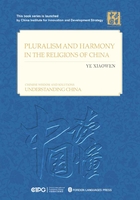
The Subordination of Religion to the Primacy of Government
All China’s traditional faiths and religions were able to coexist with all foreign religions that spread into its vast territory. That is not to say that they were able to exist independently, dissociate from China’s specific social conditions. On the contrary, they were subject to the restrictions of Chinese society, especially its political institutions.
1. The politics of official religion
Socio-politically, ancient China was an autocracy, based on patriarchal worship, ancestral kinship, Confucian ethics and the supremacy of the monarch. “There is nothing beneath the sky that is not royal territory. All that is surrounded by the seas is subject to royal command.”(7) “The sky has no second sun, the kingdom has no second king.”(8) This reverence of the monarch and the conception of the world as a household of which he was the supreme master, is the classic expression of dynastic rule in ancient China. In order to crown its autocratic rulers with a halo of divinity, the ruling classes, from the outset, were conscientious in arranging a theology that completely served their purposes and used it to symbolize the authority of a theocracy adapted to an authoritarian social hierarchy. Its major feature was to serve the supreme ruler, to legitimize and sanctify his rule. This is what we mean by official religion. The emperors’ exclusive right to pay homage to the Sky God, and to venerate the principal ancestor were the manifestation of respect for the order of heaven and ancestral decree in governmental form. That is to say, only he who had the title of supreme ruler enjoyed the right to these religious rituals. All others, including religious leaders, were excluded from these rituals, or else they would be overstepping their place in the social order, which would offend the spirits. In this sense, the monarch’s authority was equivalent to a god, there was no distinction between them.
With regards to worship of the Sky God, only the son of Heaven, the emperor, had the right to perform the oblatory rituals related to the sky and earth, Shangdi, the various deities, and to make offerings on Mt. Tai and Mt. Liangfu. The “Royal Regulations” from the Book of Rites says, “The son of Heaven pays homage to Heaven and Earth, the princes of the states, to the spirits of soil and grain, major ministers offer tribute to the five household gods. The son of Heaven pays homage to all the known hills and great streams, the five mountains receive tribute as the three ducal ministers, and the four rivers as the princes of the states. The princes give homage to the known hills and great streams in their own territories.” The scope of one’s ritual obligations was related in every aspect to the scope of one’s political office, which indeed reflects Chinese politico-religious unity. After the Qin and Han dynasties, national religion became ritualized and secularized, but ceremonies for worship of the gods of the sky and earth, and of agriculture, as well as ancestors were still constantly revised in the law codes, like the Bai Hu Tong of the Eastern Han Dynasty, and the Kai Yuan Li of the Tang Dynasty, which sought to legitimize the imperial rule on a theological basis.
2. Primacy of the state and subordination of religions
During the Xia, Shang and Zhou dynasties (including the Spring and Autumn and Warring States periods) and the Qin and Han dynasties, religion and national politics were directly connected and provided a theological basis for political power. After the Qin and Han periods, besides the continued direct assimilation of traditional patriarch worship into national political institutions, other independent religious groups, like Buddhism and Taoism, no longer politicized, were societal religions. Within the Confucian ideological framework of practical mysticism, sectarian religions would necessarily take a back seat to national politics. China’s religions have in all cases placed imperial authority in a dominant relationship to religious authority. While this government first, religion second configuration is different from a political-religious unity, it is still remarkable for the close ties between the two.
The subordination of religion to the political establishment essentially stresses the standing of the government in relation to sectarian religion. Specifically, each religious denomination must be of service to the royal authority, subject to official restrictions, and submit to administrative decisions. Ancient Chinese society’s supreme rulers would select religious doctrines that served their rule. Leaders of sectarian religions would also actively adapt to the country’s law and order. Chinese history has only an emperor, never a pope. The heads of all denominations were obligated to bow before the emperor as his subjects. Every time in China’s history when a conflict arose between religion and imperial rule, the imperial court would impose restrictions on their numbers or practices, sometimes even violently suppressing them. The well-known Three Disasters of Wu, incidents of persecution of Buddhists, are the most classic examples.
The subordination of religion to government is not the same as the unification of the two. Predicated on the control of religious authority by political authority, sectarian religions had space for relatively independent activity. Under normal circumstances the government would not interfere in their internal affairs. The political world respected the beliefs and autonomous activities of the religious community. The common people enjoyed a certain amount of freedom in choosing a faith and the relationship between government and religion remained close but not intrusive.